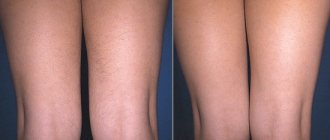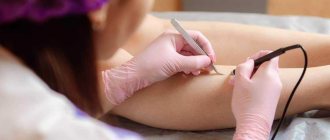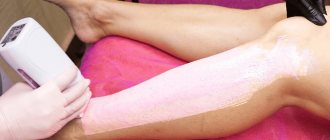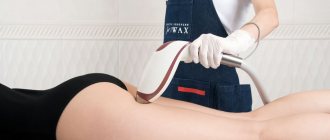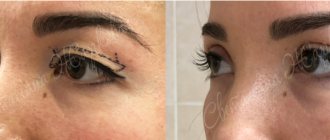Epilation of legs is the removal of hair from the skin. In the modern world, every fashionista is familiar with this process. Girls resort to removal to look beautiful; besides, well-groomed skin increases self-esteem and gives self-confidence.
Today, there are many methods for removing unwanted hair from certain parts of the body. Some of them can be used at home, while others can only be used in beauty salons. Each girl chooses the appropriate method that suits and likes her most.
Epilation and depilation: the essence of methods, types and techniques
There are two methods to get rid of unwanted vegetation. They are fundamentally different:
- hair removal (the hair follicle is destroyed or hair is removed from the root, the procedure is characterized by a long-term result);
- depilation (only the hair shaft is removed, while the follicle remains intact, and after some time a new hair grows from it).
There are practically no barriers to manual depilation; it can handle hair of any hardness and color. During processing, the hair is simply cut off. This procedure has almost no contraindications. Depilation can be done independently, and the duration of the result depends on the method of its implementation. However, it is impossible to get rid of hair forever manually. There are hardware methods for this: laser, photo and electrolysis. They are quite expensive and are not suitable for everyone due to health conditions and skin type.
Manual depilation gives a short-term effect
Hardware hair removal is the effect on hair follicles using radiation: radio wave, optical and electrical. The destruction of the structure occurs under the influence of heat. Some of these methods are not suitable for dark skin and do not work on light, gray or vellus hairs.
Using equipment to perform the procedure independently
The simplest devices for removing unwanted hair on the legs are electric epilators. These are special rollers that grab hairs and pull them out. The cars operate on mains or batteries. Some models are equipped with special cooling attachments designed to reduce the pain of the procedure.
Mechanical epilators should not be used on sensitive skin on the thighs.
These devices have a significant drawback - they can only treat legs up to the knee. The skin on the thighs is much more sensitive, and the hairs on them will have to be removed in a different way. The effect of the electric epilator is smooth skin within 3-4 weeks.
Devices for home laser hair removal are less powerful and act in a targeted manner. So you will have to spend more time treating your feet than in a salon. In terms of cost, an epilator in the mid-price category will cost approximately the same as two salon procedures. The same can be said about a household photoepilator. Taking care of consumer safety and their own good name, manufacturers provide devices with a multi-stage protection system against accidental operation. When choosing hardware hair removal at home, consider its contraindications.
The principle of “being your own cosmetologist” is justified not only financially. If you have dark hair and light skin, you can completely get rid of hair on your legs in two years using a home photoepilation device. The main thing is not to deviate from the rules. Shave your legs before epilation: the shorter the hairs, the more effectively they are removed. Carry out the procedure only on dry skin. Maintain a pause between sessions to avoid damaging the epidermis. Another advantage of home hardware hair removal is that the procedure is less painful due to the low power of the devices.
Bioepilation
Modern girls are replacing the use of a razor or cream with bioepilation. The history of this method goes back more than one thousand years, but it still remains among the leaders. The concept of bioepilation includes two methods of hair removal:
- waxing (wax depilation);
- sugaring (sugar depilation).
There are three types of waxing procedure:
- cold;
- warm;
- hot.
It is better to remove hair using the hot method in a salon. At home, it is difficult to control the temperature of heated wax, so you can get burns. The cold method is the most painful. Wax strips are perfect for leg depilation.
Read more about waxing in the article - Waxing legs at home.
Sugaring is less painful than waxing.
Sugaring is depilation with sugar paste. You can make it at home or buy ready-to-use mass. This method also cannot be called painless, but it causes less discomfort than waxing. After waxing, there is a risk of hairs growing into the skin, and the sugar procedure practically eliminates it. The main difference between sugaring is the technique of the session. During sugar depilation, hairs are removed in the direction of their growth, and not against.
In addition, sugaring is a safer procedure for those girls who are prone to allergies. Sugar paste does not contain chemical components.
The result of bioepilation will please the woman within 2–3 weeks.
According to cosmetologists, with regular sugaring or waxing, hair growth stops, as the follicles are constantly injured. But this will require much more procedures than with hardware effects on the hair.
Preparing the skin for the procedure
Before the bioepilation procedure, it is necessary to prepare the skin:
- 3-4 days before waxing or sugaring, shave your legs with a machine. During these days, the hairs will grow to the required length (3–5 mm for sugaring, no more than 6 mm for waxing) and will be stiff enough to grip well.
- The day before the procedure, cleanse the skin of dead epidermal cells and dirt using a soft scrub (you can take the one you use on your face). Apply it with massaging movements: first clockwise, then counterclockwise.
- After scrubbing, apply a thick layer of body moisturizer to your skin. It will penetrate deeply into the pores that open after cleansing and soften the hair follicles.
- Before epilating, wash your feet thoroughly with antibacterial soap and treat your skin with an antiseptic solution containing chlorhexidine. This is a classic safety measure - it will prevent skin irritation and infection.
This preparation will make waxing or sugaring less painful and reduce the risk of ingrown hairs. Additionally, lidocaine spray is used for pain relief. It is applied to the legs shortly before the procedure. Then the area of skin is covered with a film and kept for 10–15 minutes. You can start processing it when you feel cold.
Salon hair removal
Making your dream come true, the essence of which is getting rid of leg hair forever, becomes possible with the help of a course of sessions in a cosmetology clinic. Establishments of this type have modern equipment and licensed specialists. You need to understand that complete hair removal in a salon is not a quick or cheap process.
Any hardware effect is effective only in relation to growing hair, and this is no more than 15–20% of the hair on the legs. The remaining follicles are in a dormant state. Therefore, the process of completely getting rid of hair sometimes drags on for a year.
Table: modern types of procedures
| Method name | Technique |
| Laser | Laser hair removal is based on the action of light: heat that destroys the follicle is generated from the absorption of the beam by dark hair. This method is not suitable for blond and gray hair, since melanin (pigment) is absent or contained in small quantities. The whole procedure takes about half an hour (depending on the density of hair on the legs). To completely get rid of hair you will need from 8 to 10 sessions. The advantages of laser hair removal are the absence of damage to the skin and the risk of infection. |
| Photoepilation | The principle of photoepilation is similar to the laser procedure. The hairs are exposed to a light beam that destroys the follicles. Photoepilation, unlike a laser procedure, is practically painless, but also less effective. The result will last for several years, then hair growth will resume. |
| Electrolysis | Electrical hair removal is not a new method; it has been practiced since the late 19th century. Since then, the equipment has improved significantly, but the principle of the procedure remains the same. A thin electrode in the form of a needle is inserted into the skin as close as possible to the follicle and destroys it with an electrical impulse. Today, this is the most effective way to completely destroy unwanted hair (regardless of its color). The disadvantages of the method include a large number of contraindications and severe pain. Course duration is from 3 to 7 sessions. |
| Ultrasonic hair removal | Ultrasonic hair removal will help you get rid of hair on your legs painlessly and permanently. It is based on the chemical action of a special composition, which is applied on top of an antiseptic gel. Ultrasound is a conductor of substances that, penetrating the follicle, slow down cell division, stopping the formation and growth of new hairs. The process of “breeding” vegetation is long: it will take at least a year to see the final result. At the same time, doctors note the negative impact of the gel on the skin. The advantages of the method include a long-lasting effect (up to several years), low cost, painlessness and the ability to remove hair of any color. |
| ELOS hair removal | ELOS hair removal is based on two types of effects: an electrical impulse penetrates the follicle and destroys it (thermolysis method), and a laser beam heats and destroys the hair shaft. The effectiveness of the procedure increases as a result of the synergy of the two types of effects. What the laser cannot handle can be successfully removed using electricity. ELOS hair removal is suitable for removing any hair, but for light hair, more sessions will be needed. The technique has a number of contraindications, so doctors recommend doing it in a cosmetology clinic and only with a certified specialist. |
| Epilation with enzymes | Using enzymes to remove hair is a method for those for whom other salon hair removal methods are contraindicated. It is similar to an ultrasound procedure, only maximum enzyme penetration occurs under the influence of heat rather than ultrasound. A warming bandage is applied to the shin over the composition and infrared radiation is directed. The final stage is cleansing the skin of the enzyme composition and removing the remaining hairs using wax. The effectiveness of the procedure is 4 months. Its disadvantage is that the enzymes are not applicable to sensitive areas of the skin, that is, the thighs cannot be treated in this way. You can completely get rid of hair on your legs after 5-7 sessions. |
Hardware hair removal does not provide long-term results if excess hair growth on the legs is hormonal in nature.
Photo gallery: hardware hair removal methods
Laser hair removal is characterized by relatively mild pain and long-lasting results after a course of procedures (up to 6 years) Before the start of an ultrasonic hair removal session, a special gel is applied to the skin A full course of photoepilation, as a rule, ranges from 4 to 10 sessions with a frequency of every 3 weeks Before the electrolysis procedure, it is necessary make sure there are no ingrown hairs on your legs Today, ELOS hair removal is considered one of the safest methods of getting rid of unwanted hair
Preparing the skin for hair removal in the salon
Preparation for any hardware hair removal includes:
- you must avoid visiting the beach and solarium at least 2 weeks before the start of the sessions;
- approximately 8 hours before ELOS, photo or laser hair removal, legs should be shaved;
- electrolysis should be carried out on hairs at least 2.5–3 mm long;
- You cannot use creams before the session.
To reduce pain during salon procedures, special creams with a delayed analgesic effect are also used. It is applied at home an hour before the start of the session (then it has maximum effect). The cream usually comes with special patches for occlusive (hermetic) dressings. For the legs, you can use regular cling film.
Emla anesthetic cream is one of the most popular anesthetics for external use.
Waxing and sugaring
Several methods lie at the intersection of salon and home procedures, but it is better to carry them out, of course, in beauty centers. As with shaving, the follicle is not destroyed, the result lasts up to 3 weeks.
Universal methods, suitable for any part of the body without damage, moles, birthmarks.
Waxing
Waxing is a wax depilation procedure. Unwanted hairs are removed using melted wax.
Wax is available in cans, cartridges and in the form of strips. The contents of the jar/cartridge are heated, applied according to hair growth using a spatula and paper strips, and torn off against hair growth. Ordinary wax from a jar is applied in the same way.
The hot wax removal method is not suitable for home use, as it requires professional skill in working with the product ().
The result lasts up to 1 month; you need to grow your hair to 4-5 mm for the wax to cling to it.
The main disadvantage is that the procedure is very painful and can injure the skin, especially delicate, sensitive ones.
An alternative to hot wax is special wax strips. The strips represent a woven or non-woven base with wax and additives applied to it. Created exclusively for home use, safe and easy to use. Effect up to 4 weeks ()!
…
Sugaring
Sugar hair removal is a classic hair removal method. It is believed that Cleopatra used it to keep her skin smooth and beautiful.
The method is quite simple - you use caramel, a paste based on water and sugar, apply it to the skin, and after cooling, remove it along with the hairs. It’s easy to make the paste yourself or buy it ready-made at a specialty store. If you want to make depilation as painless as possible, then you should buy a paste from a famous brand - the pastes are made taking into account the area of application, and have different consistencies and compositions ().
Advantages: fast (hair can be removed in one procedure), inexpensive, universal (suitable for any part of the body), allergic reactions are extremely rare, sugar paste removes even short hairs (it is recommended to grow it a little to improve the effect). Remove the paste in strips following hair growth, which minimizes the likelihood of ingrown hairs.
Of the home options, the simplest and safest option is sugaring: it is safe with a relatively good effect. Minimum contraindications: herpes, open skin lesions, diabetes, pregnancy.
Recipes for home hair removal
Sugaring is the most suitable method for home hair removal. It is impossible to burn yourself with sugar paste - it is used in a slightly warm state (warmed up by the warmth of your hands). The composition is easily washed off with warm water. It's very easy to prepare.
Classic
Ingredients:
- 1 cup of sugar;
- 1/4 cup water;
- 1/4 cup lemon juice.
Cooking method:
- Pour sugar with water and juice and put on fire.
- Once the syrup has melted, simmer over low heat for about 10 minutes, stirring constantly, until bubbles appear.
- Check doneness with cold water. Drop a little syrup into it, if the drop has frozen, then the sugar paste is ready.
- Cool the mixture and begin depilation.
Vinegar paste
This mixture is similar in preparation to lemon paste, but the latter is replaced with 6% apple cider vinegar. The proportions will also change:
- 1 cup of sugar;
- 1/8 part water;
- 1/8 part vinegar.
During cooking, the mixture emits a not very pleasant smell, so it is better to keep the window open.
Honey mixture
Paste with honey is easier to prepare and is more sticky. Its ingredients are as follows:
- 1 cup of sugar,
- 1/4 cup honey;
- 1/4 cup lemon juice.
To prepare the pasta you need:
- Mix ingredients in a microwave-safe bowl.
- Heat in it until bubbles form.
- Remove the mixture from the microwave and stir thoroughly.
- Repeat this several times until the paste thickens.
- Check readiness in the same way as for the sugar mixture.
This is what the paste for sugar depilation should look like
. The author’s own experience shows that it is better to undercook the paste a little rather than overcook it, then it’s easier to fix everything. You just need to melt and boil the mixture for a few more minutes. If the paste does not knead in your hands, then it is unsuitable for use. The quantity required for 1 session is individual. It depends on the surface area being treated and the thickness of the hair. If during the procedure the paste stops stretching and simply tears in your hands, it must be replaced with a fresh one.
Hair bleaching
If you have sparse black hair growing on your legs, you can try to get rid of it by bleaching. There are special pastes on sale for lightening body hair. Regular 3% hydrogen peroxide will also work. To do this, use a cotton pad soaked in a peroxide solution with a small amount of ammonia to wipe problem areas of the skin several times a day. The hairs not only lighten, but over time they become brittle and then disappear completely.
It should be noted that the effectiveness of getting rid of hair using hydrogen peroxide is a controversial issue. Everything is individual, so you shouldn’t place special hopes on this method.
Wash off the solution of ammonia and hydrogen peroxide from the skin using ordinary soap.
Video: getting rid of leg hair with hydrogen peroxide
Home Remedies to Slow Hair Growth
In order not to once again “poison” the skin with chemicals, after each depilation, use one of the simple home remedies to slow down hair growth:
- wipe the skin with a slice of lemon and after a quarter of an hour, rinse it with cool water;
- mix lemon juice with sugar (it should not dissolve) and treat the skin with it;
- make a paste of turmeric and water, apply it to your feet and wrap in film for 15 minutes, then rinse with water;
- treat your feet with laundry soap and leave for 10 minutes, then rinse with water.
These products contain acids and alkalis that dry out the skin; be sure to use a moisturizer after using them.
The number of necessary procedures and the interval between them
The first session of laser hair removal on legs ensures 25% hair removal. On days 7–10 after the procedure, hairs begin to fall out, but after 4–6 weeks the laser should be repeated to affect those follicles that will enter the growth phase.
The third session is usually carried out at an interval of 6-8 weeks, the fourth - after 8-10 weeks. How many laser hair removal procedures are needed for legs? It all depends on the individual characteristics of the body, but on average, 6 to 10 sessions are required. Then laser treatment can be done once a year for prevention.
In any case, only a cosmetologist can give you a clear answer to the question of how many sessions of laser hair removal of legs you need. He will determine which schedule of procedures will be most effective.
Contraindications
A true woman takes care of herself and takes care of herself in any condition. However, not all types of hair removal are acceptable during pregnancy and breastfeeding. This is especially true for chemical methods. There are a number of medical contraindications to hardware methods:
- skin diseases;
- diabetes;
- phlebeurysm;
- oncology of any localization;
- epilepsy and psychotic conditions;
- severe heart pathologies;
- long-term use of oral contraceptives, antibiotics and medications that reduce blood clotting;
- scars or raised moles on the legs.
Electrical procedures are contraindicated if you have a pacemaker or metal implants.
Chemical hair removal should not be performed on teenagers who have not reached puberty.
During pregnancy, it is better to refrain from any painful methods of hair removal, especially for those who are at risk of miscarriage. Bioepilation and hardware methods are not recommended to be performed during menstruation, three days before and after it. During this period, women's sensitivity to pain increases sharply. Alcohol and coffee increase the risk of bruising after waxing.
Possible complications
Of course, performing the procedure by a highly qualified specialist reduces the risk of complications after laser hair removal to a minimum. However, there may be situations in which negative consequences are still likely. For example, pigment spots may appear on the skin, especially if the client does not follow the post-procedure care recommendations.
Burns may occur on particularly sensitive skin. In this case, it is necessary to use healing ointments or creams containing panthenol. This is an excellent remedy for restoring the skin.
If your legs itch after laser hair removal, you should also use moisturizing and soothing creams.
Scars may appear on the skin if the client independently tries to remove the crusts that have formed on the treated areas, which is strictly forbidden to do. The crusts must dry out and fall off on their own, otherwise the upper layers of the epidermis can be significantly injured. However, if scars have already formed, all that remains is to wait until the dermis recovers.
If after a laser hair removal session you experience a cycle disorder, be sure to contact your gynecologist.
We recommend
Laser aesthetic cosmetology: perfect technology for an ideal appearance Read more
Possible consequences
Some types of hair removal leave noticeable damage to the epidermis. Irritation, black spots, and ingrown hairs may appear on the skin. The use of hardware methods usually does not lead to such consequences if the procedure is performed by an experienced technician in full compliance with the technology of its implementation. But when removing unwanted vegetation at home, anything is possible. How to deal with unpleasant consequences?
All methods of getting rid of hair on the legs are more or less painful, and some are unsafe if the procedure is not performed correctly.
Blackheads and ingrown hairs
Black dots after waxing are ingrown hairs. During the procedure, the follicle is damaged and the direction of growth of the hair shaft changes. He is forced to make a new channel in the epidermis. The skin on the legs is quite dense. Thinning hair is unable to grow outward, and it bends inward. This phenomenon is not only a cosmetic defect, it can cause inflammation of the skin.
Ingrown hairs appear as black dots
How to get rid of the problem:
- A few days after the procedure, you can pick up the hairs with a needle and pluck them out with tweezers (if there are only a few of them), while maintaining complete sterility of the instrument and the treated skin surface;
- It is better to temporarily refuse wax and switch to regular shaving (if there are a lot of ingrown hairs and they appear after each depilation);
- you should constantly use scrubs that make the skin thinner and more tender;
- It is recommended to moisturize, soften and relieve irritation from ingrown hairs using tea tree ether (3 drops for any base oil).
Switching to a razor is a necessary measure. Shaved hair grows back as a hard “stump” that easily pierces the skin. By following the described procedures for two weeks, you will get rid of the maximum amount of ingrown vegetation. It is worth considering replacing wax depilation, for example, with sugaring. As a rule, it does not give such unpleasant consequences. In any case, combine depilation procedures with the use of a cream to slow down hair growth and use skin softening products.
Irritation and acne
The constant traumatic effect of mechanical and chemical agents inevitably leads to skin irritation. On the legs it requires no less care than in the delicate intimate area or in the armpits.
Cream with panthenol eliminates irritation and heals the skin after hair removal
In addition, ingrown hairs can become inflamed and form ulcers. An infusion of chamomile, calendula or celandine will help get rid of itching, irritation and disinfect the skin. Creams with panthenol will have a healing effect.
Home methods for removing hair on legs
Classic home methods (5>):
- Shaving: depilation using a machine is a simple and affordable method of hair removal, but the effect is short-lived - after 1-2 days it is tactilely felt and becomes visible. Disadvantages: traumatic (it is easy to damage the skin, cut yourself, after which scars remain), irritation, ingrown hairs. The skin will be beautiful and smooth after shaving only on the third or fourth day. For sensitive skin, such depilation is contraindicated.
- Using cream: using cream, hair is removed without injury or irritation, but the effect is very short-lived.
Advantages: low cost and availability; the procedure is easy to carry out without special equipment.
Disadvantages: low efficiency, short-term effect.
There are also traditional methods of hair removal. They use peroxide, tinctures of plants - hemlock, walnuts, mixtures of iodine and ammonia, potassium permanganate and other options. There are doubts about the effectiveness, as well as about safety.
Table: Advantages and disadvantages of different types of hair removal and depilation
| Hair removal method | Advantages | Flaws |
| Waxing |
|
|
| Sugaring |
| painful procedure |
| Enzyme hair removal |
|
|
| Hardware | high efficiency |
|
Waxing legs at home
Waxing can be cold (wax strips) or hot (hot melted wax). Every girl knows about wax strips. This method is simple. You need to stick the wax strip on your leg, wait a little and sharply tear it off in the direction of hair growth. Wax strips allow you to quickly remove unwanted hair, a well-advertised and widespread product. However, it is quite difficult to achieve perfect cleanliness with its help.
Firstly, many hairs are not pulled out by the roots, but only broken off. Consequently, after a few days there will be no initial smoothness. Secondly, short hairs are not captured at all; they will have to be removed with tweezers. Thirdly, to remove hair from both legs completely (and not just up to the knee), one package will not be enough.
Speaking of disadvantages, we cannot fail to mention that pulling out large amounts of hair is painful and can cause irritation on the skin.
Epilation with hot wax or waxing gives ideal smoothness for 1.5-2 weeks. Hot wax is applied to the skin in a molten state. When hardened, it captures all hairs, even the shortest and thinnest. The frozen layer of wax needs to be picked up and sharply pulled off, like a strip of wax. The procedure is also painful, but allows you to achieve better results compared to wax strips.
1-1.5 weeks after the procedure, individual hairs will begin to appear. They are quite thin and almost invisible. A repeat procedure will be required only after 2-2.5 weeks, when the hair becomes noticeable on the skin. Constant epilation of legs with hot wax will increase the time between procedures to 3-4 weeks.
The disadvantages of wasking include the fact that it requires certain training and skills. In salons, a special device is used to heat wax. At home, you can use the microwave, or heat the wax in a water bath. In this case, you need to be very careful, because... It is easy to overheat and cause skin burns. The wax must be heated to a temperature of 45-50 degrees. At this temperature, it will resemble the consistency of thick honey.
How to care for your feet after the procedure
In the salon, immediately after the session, the doctor applies a special cream with a softening and soothing effect to the skin. Proper subsequent foot care is the key to a successful hair removal course.
Any hair removal or depilation is stressful for the skin. Natural coconut oil soothes and relieves irritation. It will get rid of red spots and quickly heal the skin.
If coconut oil remains solid at room temperature, it is natural.
It is not recommended to use skin care products containing glycerin after the procedure. It clogs pores, which can cause ingrown hairs. Also, to prevent this undesirable consequence, it is advisable to start using a scrub a few days after the procedure. After hardware hair removal sessions, it is prohibited:
- sunbathe for a week;
- visit the pool, bathhouse or sauna;
- visit the gym for 7 days (after electrolysis).
Before epilation
In order for the treatment of the hair surface of the body to be successful and give maximum effect, it is necessary to carefully prepare for the procedure:
- do not sunbathe in direct sunlight or in a solarium at least 2 weeks before the session. If you need to be in the sun, you need to use an anti-tanning product SPF 30+;
- 2-3 weeks before the session it is not recommended to carry out any hair removal; sugaring or waxing, which damage the follicles, making the laser ineffective, is strictly prohibited;
- in preparation for the procedure, you can simply shave off the abundant hair with a simple safety razor, since the laser is most effective on short hair no more than 2 mm long.
What doctors say about hair removal and depilation
According to doctors, the safest methods of depilation are waxing and sugaring. The most unacceptable methods of removing leg hair are shaving and using cream, since there is a high risk of allergies to the ingredients and there is a risk of injury and infection of the skin. In addition, mechanical and chemical depilation are ineffective. Hardware hair removal is contraindicated for certain diseases and conditions. The main thing is to take into account contraindications and ensure that the procedures are carried out at a high professional level.
A specialist will be able to assess your health status, skin type and the possibility of using certain methods of hair removal or depilation.
Carrying out the procedure
After the skin is thoroughly prepared and the machine is ready for use, you can begin to excise the hairs. How to properly epilate your legs with an epilator? Removing vegetation in this way occurs as follows:
- Lubricate the skin with a special shaving product or sprinkle with talcum powder.
- Turn on the machine and test it on a small area of skin.
- Move the head of the epilator towards your leg at an angle of 90 degrees and, with slow movements, begin to remove hair against its growth (from bottom to top).
- Treat the entire surface of your legs in this way, slightly stretching the skin in the process. This will help reduce pain.
- At the end of the procedure, wash and dry your feet, then apply a moisturizing, soothing cream or lotion. The machine also needs to be cleaned with a special brush.
Shaving your legs with an epilator takes approximately 1-1.5 hours. During the epilation process, all movements should be light, fast and jerky. At first, the painful sensations will be pronounced, but after a few sessions they will significantly decrease.
How does an epilator work?
An epilator is a mechanical device that contains rotating discs with tweezers. These devices operate from batteries or from an electrical network. Under the influence of current, the discs rotate and the tweezers open and close, capturing and pulling out hairs from the roots. As a rule, on modern epilators you can select the required speed mode. The price of the device is low, and almost every woman can buy it now.
At first, the devices were used to make legs smooth, but now their scope of application has expanded significantly. Now they are used for epilation of armpits and bikini area.
Special attachments have been developed to reduce pain and improve hair removal quality. Of course, this increases the price of the device.
For example, massage attachments are very popular, which allow tweezers to grab hairs in the most inconvenient places. They also knead the skin and make it softer and more pliable. Subsequently, such a massage helps to avoid irritation after hair removal.
And when using cooling attachments, the procedure is not so painful. This is especially true for the bikini area.
Useful tips
To make the hair removal procedure using an epilator more enjoyable and effective, the following recommendations should be followed:
- you need to start using the device at minimum speed;
- Do not apply too much pressure with the epilator;
- all movements must be smooth and slow;
- if the hairs are longer than 7 mm, then they need to be trimmed a little with scissors;
- It is best to start epilation from areas with the least amount of vegetation;
- pauses should be taken during the session;
- You should not give your machine to anyone, as it is a personal hygiene item.
To reduce pain, it is recommended to turn on pleasant music and think about something good. If shaving with an epilator causes severe discomfort, then it is better to give preference to another method of depilation.
